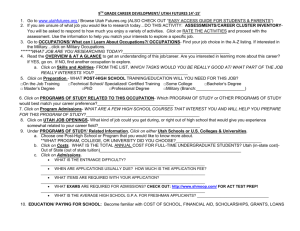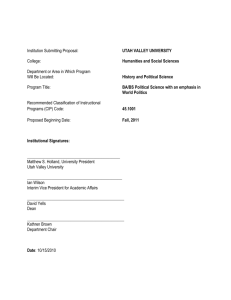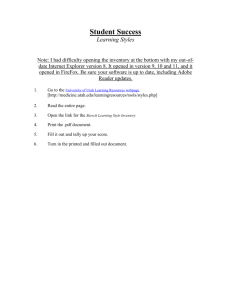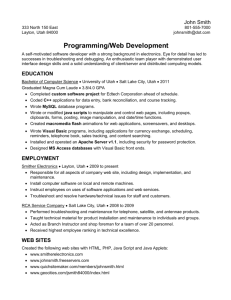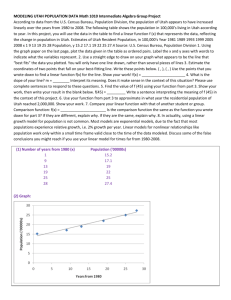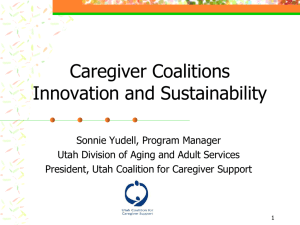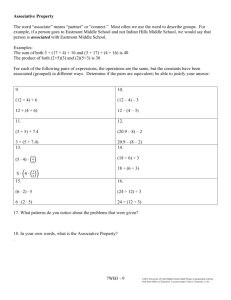transition timeline - Family Voices Indiana
advertisement
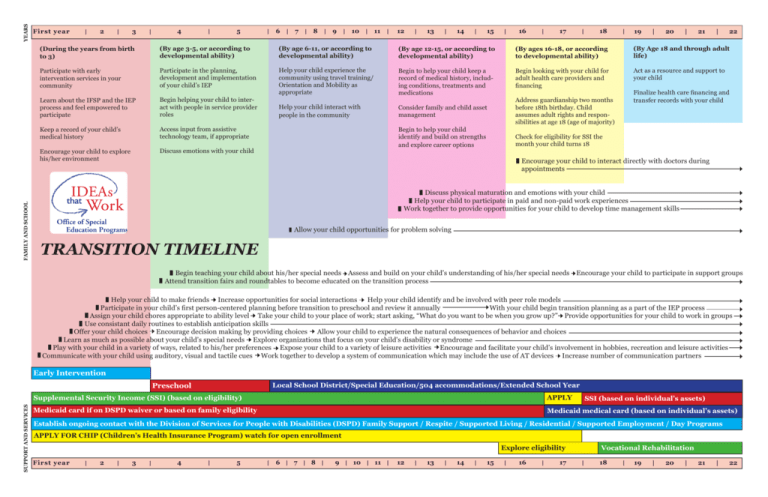
YEARS FAMILY AND SCHOOL First year | 2 | 3 | 4 | 5 | 6 | 7 | 8 | 9 | 10 | 11 | 12 | 13 | 14 | 15 | 16 | 17 | 18 | 19 | 20 | 21 | 22 (During the years from birth to 3) (By age 3-5, or according to developmental ability) (By age 6-11, or according to developmental ability) (By age 12-15, or according to developmental ability) (By ages 16-18, or according to developmental ability) (By Age 18 and through adult life) Participate with early intervention services in your community Participate in the planning, development and implementation of your child’s IEP Help your child experience the community using travel training/ Orientation and Mobility as appropriate Begin to help your child keep a record of medical history, including conditions, treatments and medications Begin looking with your child for adult health care providers and financing Act as a resource and support to your child Learn about the IFSP and the IEP process and feel empowered to participate Begin helping your child to interact with people in service provider roles Keep a record of your child’s medical history Access input from assistive technology team, if appropriate Encourage your child to explore his/her environment Discuss emotions with your child Help your child interact with people in the community Finalize health care financing and transfer records with your child Address guardianship two months before 18th birthday. Child assumes adult rights and responsibilities at age 18 (age of majority) Consider family and child asset management Begin to help your child identify and build on strengths and explore career options Check for eligibility for SSI the month your child turns 18 Encourage your child to interact directly with doctors during appointments Discuss physical maturation and emotions with your child Help your child to participate in paid and non-paid work experiences Work together to provide opportunities for your child to develop time management skills Allow your child opportunities for problem solving TRANSITION TIMELINE Begin teaching your child about his/her special needs Assess and build on your child’s understanding of his/her special needs Attend transition fairs and roundtables to become educated on the transition process Encourage your child to participate in support groups Help your child to make friends Increase opportunities for social interactions Help your child identify and be involved with peer role models Participate in your child’s first person-centered planning before transition to preschool and review it annually With your child begin transition planning as a part of the IEP process Assign your child chores appropriate to ability level Take your child to your place of work; start asking, “What do you want to be when you grow up?” Provide opportunities for your child to work in groups Use consistant daily routines to establish anticipation skills Offer your child choices Encourage decision making by providing choices Allow your child to experience the natural consequences of behavior and choices Learn as much as possible about your child’s special needs Explore organizations that focus on your child's disability or syndrome Play with your child in a variety of ways, related to his/her preferences Expose your child to a variety of leisure activities Encourage and facilitate your child’s involvement in hobbies, recreation and leisure activities Communicate with your child using auditory, visual and tactile cues Work together to develop a system of communication which may include the use of AT devices Increase number of communication partners Early Intervention Local School District/Special Education/504 accommodations/Extended School Year SUPPORT AND SERVICES Preschool Supplemental Security Income (SSI) (based on eligibility) APPLY Medicaid card if on DSPD waiver or based on family eligibility Medicaid medical card (based on individual’s assets) SSI (based on individual’s assets) Establish ongoing contact with the Division of Services for People with Disabilities (DSPD) Family Support / Respite / Supported Living / Residential / Supported Employment / Day Programs APPLY FOR CHIP (Children’s Health Insurance Program) watch for open enrollment Explore eligibility First year | 2 | 3 | 4 | 5 | 6 | 7 | 8 | 9 | 10 | 11 | 12 | 13 | 14 | 15 | 16 | 17 Vocational Rehabilitation | 18 | 19 | 20 | 21 | 22 Additional Supports Available Contact Information Access Utah 801-325-5823 www.accessut.state.ut.us Allies with Families 800-829-8200/801-584-8284 http://health.utah.gov/cshcn American Association of the Deaf-Blind (AADB) www.aadb.or Assistive Technology Lab, USU 435-797-0699 Centers for Independent Living 801-538-7530/ 800-473-7530 www.usor.utah.gov/il.htm Children with Special Health Care Needs (CSHCN) 801-292-2515 http://heath.utah.gov/cshen Children’s Health Insurance Policy (CHIP) 888-222-2542 http://health.utah.gov/chip DBLINK: National Information Clearinghouse on Children Who Are Deaf-Blind 800-438-9376 www.tr.wou.edu/dblink Disability Determination Services (SSI Eligibility) 801-321-6500 Disability Law Center 800.662-9080 www.disabilitylawcenter.org Division of Services for People with Disabilties (DSPD) 801-264-7620 www.hsdspd.state.ut.us Division of Services for the Blind and Visually Impaired 801-323-4343 www.usor.utah.gov/dsbvi.htm Division of Substance Abuse and Mental Health Community Centers 801-538-3939 www.hsmh.utah.gov Forward Motion 801-536-3523 Guardianship Associates of Utah 801-533-0203/888-498-0203 Hearing, Speech and Vision Services, Dept. of Health 801-584-8215 www.health.utah.gov/cshcn/hsvs/ Helen Keller National Center for Deaf-Blind Youth and Adults (HKNC) 516-944-7302 www.helenkeller.org/national Hilton/Perkins Program - Perkins School for the Blind http://www.perkins.pvt.k12.ma.us/ Interagency Coordinating Council www.babywatch.org/ICC/Introduction_page_1.htm Medicaid 800-662-9651 http://health.utah.gov/medicaid National Family Association for Deaf-Blind (NFADB) 800-255-0411 http://nfadb.org/ Office of Public Guardian 801-538-8255 www.dhs.utah.gov/pdf/hot-tips.pdf Planned Parenthood Association of Utah (Maturation programs) 800-627- 9558 www.plannedparenthood.org/utah/real-life-real-talk.htm Retired VIPS (Visually Impaired Persons) 801-585-2213 Robert G. Sanderson Community Center for the Deaf 800-860-4860 www.deafservices.utah/gov Salt Lake County Parks and Recreation 801-468-2299 www.parks-recreation.org SibShop www.thearc.org/siblingsupport/sibshops-directory.shtml Social Security Administation 800-772-1213 www.ssa.gov State Family Council 877-352-2221 The ARC of Utah 801-364-5060 www.arcutah.org Ticket To Work 801-524-4145 x 3883/801-538-7590 Utah Assistive Technology Foundation 800524-5152 www.uatf.org Utah Cares www.utahcares.utah.org Utah Center for Assistive Technology (UCAT) 888-866-5550/ http://www.usor.utah.gov/ucat Utah Collaborative Medical Home Project 801-584-8584 http://medhome.med.utah.edu Utah Department of Health Baby Watch Early Intervention Program 801-961-4226 www.utahbabywatch.org Utah Developmental Disabilites Council 801-533-3965 www.gcpd.org Utah Industries for the Blind 801-269-0314 Utah Parent Center 801-272-1051 www.utahparentcenter.org Utah Schools for the Deaf and the Blind, Deafblind Division 801-629-4732 www.usdb.org/departments/DeafBlind Utah State Office of Education (USOE) 801-538-7500 www.schools.utah.gov Utah State Office of Rehabilitation (USOR) 801-538-7530 www.usor.utah.gov Utah State University Center for Person’s with Disabilities 435-797-1981 www.cpd.usu.edu Utah Transit Authority/Paratransit 801-566-2334 www.rideuta.com/paratransit/ WorkAbility (Medicaid Work Incentives) 877-246-9675 www.workabilityutah.org Transition Timeline For Children and Adolescents with Deafblindness and/or Severe Disabilities Children and families experience many transitions, large and small, over the years. Three predictable transitions occur: 1. When children reach school age. 2. When they approach adolescence. 3. When children move from adolescence to adulthood. Other transitions children make include moving into new programs, working with new agencies and care providers, and making new friends. Transition involves changes, adding new expectations, responsibilities, or resources, and letting go of others. As a parent of a child with deafblindness or other severe disabilities you may be caught up in dayto-day survival. You may ask, “How can I think about tomorrow when I’m just trying to make it through today?” But when those moments come, when you can catch your breath, it may be helpful to be aware of those transitions and allow yourself to think about the future. The Transition Timeline for Children and Adolescents with Deafblindness and/or Severe Disabilities may help you think about the future. We hope this timeline will give you ideas to help your child achieve independence as you face the transitions ahead of you. Adapted by Utah’s Deafblind Project, Transition Task Force. Sources Intermountain Collaborative Resource Center. “Transition Timeline for Children and Adolescents with Special Health Care Needs.” Bloomberg, R. & Petroff, J. (2003, April). Quality Indicators for Transition Service - A Tool for Self Assessment and Program Development. Presented at NTAC Topical Workshop, Transitioning to a New L(Attitude), San Antonio, Texas. Petroff, J. (2003, April). Comprehensive Transition Protocol. Presented at NTAC Topical Workshop, Transitioning to a New L(Attitude), San Antonio, Texas. For more information and additional copies please contact: Deafblind Division, 742 Harrison Boulevard, Ogden, UT 84404, 801-629-4732, Toll Free 1-800-990-9328, TDD 801-629-4701. Developed by Utah’s Deafblind Project and funded through the U.S. Department of Education, OSERS, Special Education Programs, Grant Award No. H326C030012. This Timeline can be reproduced for educational purposes only. The timeline can be found at http://www.usdb.org/db/db/trainingandtechnicalassistance.html
